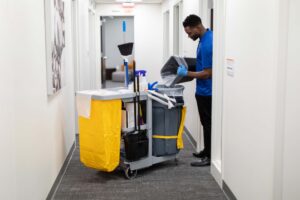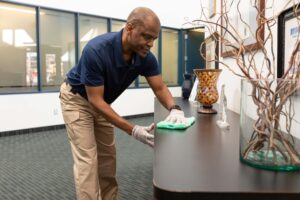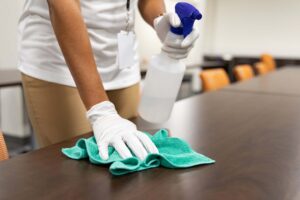Summer is just around the corner, and as a facility manager, you know that preparing your building for the warmer months is crucial to maintaining a safe, comfortable, and efficient environment.
From increased foot traffic to higher temperatures and humidity levels, summer brings a unique set of challenges that can put a strain on your facility’s systems and surfaces.
That’s why it’s essential to have a comprehensive cleaning and maintenance plan in place to ensure that your building is ready to handle whatever the season brings.
At 1 Stone Solutions, we understand the importance of proactive facility maintenance, and we’ve put together this detailed checklist to help you tackle the key areas of your building and get it ready for summer.
By following these steps, you can not only enhance the appearance and functionality of your facility but also extend the life of your assets and create a welcoming environment for occupants and visitors alike.
Exterior Maintenance: Protecting Your Facility’s First Impression
Your facility’s exterior is the first thing that people see when they approach your building, and it plays a significant role in creating a positive first impression. To ensure that your facility looks its best and is protected from the elements, it’s important to focus on the following areas:
Inspect and Clean Gutters and Downspouts
Over time, gutters and downspouts can become clogged with debris, such as leaves and twigs, which can lead to water damage and other issues.
Before summer arrives, take the time to inspect your gutters and downspouts and remove any accumulated debris. This will help to ensure that water is properly channeled away from your building, preventing potential damage to your foundation, walls, and other structures.
When cleaning your gutters, be sure to follow proper safety protocols, such as using a sturdy ladder and wearing gloves to protect your hands. If you’re not comfortable performing this task yourself, consider hiring a professional gutter cleaning service to handle it for you.
Check and Maintain Landscaping
Your facility’s landscaping is another important aspect of its exterior appearance, and it requires regular maintenance to keep it looking neat and well-manicured.
This includes tasks such as mowing lawns, trimming shrubs and trees, and checking irrigation systems to ensure that they are functioning properly.
In addition to aesthetic considerations, maintaining your landscaping is also important for safety reasons. Overgrown vegetation can obstruct pathways and entrances, creating tripping hazards and making it difficult for people to navigate your facility.
By keeping your landscaping well-maintained, you can help to prevent accidents and ensure that your building is accessible to everyone.
Exterior Surface Cleaning
Over the course of the year, your facility’s exterior surfaces, such as sidewalks, driveways, and building facades, can accumulate dirt, grime, and other debris. Not only does this detract from the appearance of your building, but it can also lead to damage and deterioration over time.
To restore your exterior surfaces to their former glory, consider investing in professional pressure washing services. Pressure washing uses high-powered water jets to remove built-up dirt and grime, leaving your surfaces looking clean and refreshed. This not only enhances the curb appeal of your facility but also helps to extend the life of your exterior surfaces by preventing damage from moisture and other environmental factors.
HVAC System Maintenance: Ensuring Indoor Comfort and Air Quality
As temperatures rise during the summer months, your facility’s HVAC system will be working harder than ever to keep indoor spaces cool and comfortable.
To ensure that your system is up to the task, it’s important to perform regular maintenance and inspections:
Inspect and Clean Air Conditioning Units
Your air conditioning units are the workhorses of your HVAC system, and they require regular maintenance to operate at peak efficiency.
Before summer arrives, schedule a professional inspection of your AC units to ensure that they are in good working order and ready to handle the increased demand.
During the inspection, be sure to have your technician clean or replace any clogged or dirty air filters. This will help to improve indoor air quality and reduce strain on your AC units, leading to better performance and energy efficiency.
Check and Service Ventilation Systems
In addition to your AC units, your facility’s ventilation systems also play a crucial role in maintaining indoor comfort and air quality.
Over time, these systems can become clogged with dust, debris, and other contaminants, reducing their effectiveness and potentially leading to indoor air quality issues.
To keep your ventilation systems in top condition, schedule regular inspections and servicing with a qualified HVAC technician.
This may include tasks such as cleaning ductwork, checking for leaks or damage, and ensuring that all components are functioning properly. By investing in regular maintenance, you can help to extend the life of your ventilation systems and ensure that they are providing optimal performance.
Interior Cleaning and Maintenance: Creating a Welcoming Environment
While exterior maintenance and HVAC system upkeep are important, it’s also crucial to focus on the interior of your facility to create a clean, welcoming environment for occupants and visitors.
Here are a few key areas to address:
Deep Cleaning Carpets and Floors
Carpets and floors are some of the most heavily-used surfaces in your facility, and they can quickly become stained, dirty, and worn over time. To restore them to their former glory, consider investing in professional deep cleaning services.
For carpets, this may involve hot water extraction or steam cleaning to remove deep-seated dirt, allergens, and stains. For hard surface floors, such as tile or wood, deep cleaning may include scrubbing, polishing, and sealing to restore their shine and protect them from future damage.
Window and Glass Cleaning
Clean windows and glass surfaces not only enhance the appearance of your facility but also allow in more natural light, creating a brighter, more inviting atmosphere.
To achieve a streak-free shine, consider hiring a professional window cleaning service that uses specialized equipment and techniques.
While you’re at it, be sure to inspect your windows and glass surfaces for any signs of damage, such as cracks or broken seals. Addressing these issues promptly can help to prevent further damage and improve the energy efficiency of your building.
Dusting and Disinfecting Surfaces
Dust, dirt, and germs can accumulate quickly on surfaces throughout your facility, creating an unsightly and potentially unhealthy environment. To combat this, implement a regular dusting and disinfecting schedule that targets high-touch areas, such as doorknobs, light switches, and countertops.
When disinfecting surfaces, be sure to use products that are effective against a wide range of bacteria and viruses, and follow the manufacturer’s instructions for use. This will help to ensure that your facility is not only clean but also hygienic and safe for occupants and visitors.
Safety Checks and Precautions: Prioritizing the Well-Being of Your Occupants
As a facility manager, the safety and well-being of your occupants should always be a top priority. To ensure that your facility is prepared for any potential emergencies or hazards, it’s important to conduct regular safety checks and implement appropriate precautions:
Inspect Fire Safety Equipment
Fire safety equipment, such as smoke detectors, fire extinguishers, and sprinkler systems, are critical components of your facility’s emergency preparedness plan. To ensure that they are in good working order, schedule regular inspections and testing with a qualified fire safety professional.
During these inspections, be sure to check that all equipment is up to date and properly maintained and that any necessary repairs or replacements are made promptly. This will help to ensure that your facility is prepared to respond effectively in the event of a fire or other emergency.
Review and Update Safety Protocols
In addition to maintaining your fire safety equipment, it’s also important to review and update your facility’s safety protocols on a regular basis. This may include tasks such as updating emergency contact lists, reviewing evacuation procedures, and conducting safety drills and training for staff.
By ensuring that your safety protocols are up to date and well-understood by all occupants, you can help to minimize the risk of accidents and injuries and ensure that everyone knows what to do in the event of an emergency.
Facility-Specific Considerations: Tailoring Your Approach to Your Unique Needs
While the above checklist provides a solid foundation for preparing your facility for summer, it’s important to remember that every building is unique and may have its own specific needs and requirements. Here are a few examples of facility-specific considerations to keep in mind:
School and Educational Facilities
If you manage a school or educational facility, summer may be a time when your building is used for a variety of different purposes, such as summer school programs, camps, or community events.
To ensure that your facility is ready for these activities, focus on cleaning and organizing classrooms, cafeterias, and common areas, and consider any special needs or requirements that these programs may have.
For example, if you’re hosting a summer camp, you may need to ensure that your facility has adequate outdoor play areas, as well as indoor spaces for activities and meals.
By taking the time to understand the unique needs of your summer programs, you can help to create a safe, welcoming environment for all participants.
Healthcare Facilities
Healthcare facilities, such as hospitals and clinics, have some of the most stringent cleaning and maintenance requirements of any type of building.
To ensure that your facility complies with all relevant health and safety standards, it’s important to implement specialized cleaning protocols and use hospital-grade disinfectants and equipment.
This may include tasks such as implementing a color-coded cleaning system to prevent cross-contamination, using HEPA filtration systems to improve indoor air quality, and training staff on proper infection control procedures.
By adhering to these strict standards, you can help to create a safe, sterile environment that promotes healing and reduces the risk of healthcare-associated infections.
Religious and Community Centers
Religious and community centers often serve as gathering places for a wide variety of events and activities, from worship services to social events and community meetings.
To prepare your facility for summer, focus on cleaning and organizing spaces such as sanctuaries, meeting rooms, and kitchens, and consider any specific requirements or traditions that may need to be taken into account.
For example, if your facility includes sacred spaces or religious artifacts, it’s important to handle these items with care and respect, following any specific guidelines or protocols that may be in place.
By taking a sensitive, thoughtful approach to cleaning and maintenance, you can help to create a welcoming, respectful environment for all who use your facility.
Office Buildings
For office buildings, summer may bring an increase in occupancy as employees return from vacation and businesses ramp up their activities.
To prepare for this increased usage, focus on cleaning and maintaining common areas such as lobbies, restrooms, and break rooms, and consider implementing a more frequent cleaning schedule to keep up with the increased demand.
In addition to regular cleaning, it’s also important to ensure that your office building is equipped with the necessary amenities and services to keep occupants comfortable and productive during the summer months.
This may include tasks such as ensuring that your HVAC system is properly maintained, stocking restrooms with necessary supplies, and providing ample hydration stations to keep employees cool and hydrated.
Final Thoughts
Preparing your facility for summer involves a comprehensive approach to cleaning, maintenance, and safety that takes into account the unique needs and requirements of your building and its occupants.
By following the checklist outlined in this blog post, you can help to ensure that your facility is ready to handle the challenges of the summer months, from increased foot traffic and higher temperatures to the need for enhanced cleaning and disinfection protocols.
At 1 Stone Solutions, we understand the importance of maintaining a clean, safe, and welcoming environment for your facility, and we’re here to help.
Our team of experienced professionals offers a wide range of cleaning and maintenance services that are tailored to the specific needs of your building.
If you’re looking for a partner to help you prepare your facility for summer, we invite you to contact us today to learn more about how we can help.
With our expertise, attention to detail, and commitment to customer satisfaction, we can help you create a facility that is not only clean and well-maintained but also a true asset to your organization.
So why wait?
Take the first step towards a summer-ready facility today, and let 1 Stone Solutions be your guide.



